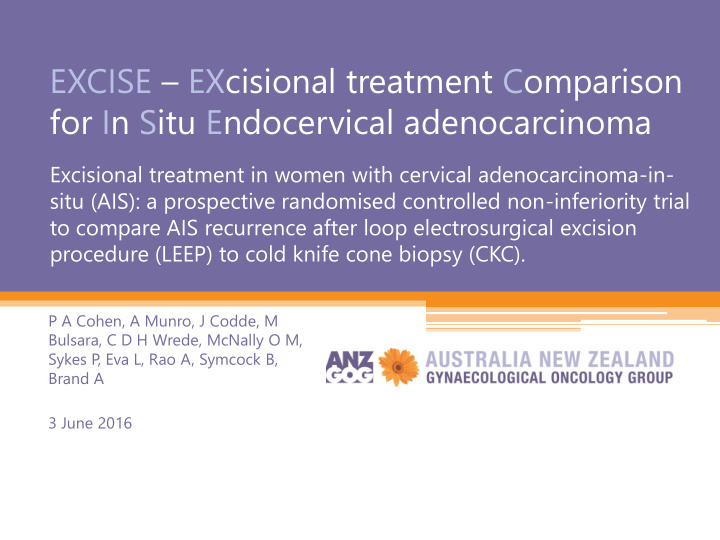



EXCISE – EXcisional treatment Comparison for In Situ Endocervical adenocarcinoma Excisional treatment in women with cervical adenocarcinoma-in- situ (AIS): a prospective randomised controlled non-inferiority trial to compare AIS recurrence after loop electrosurgical excision procedure (LEEP) to cold knife cone biopsy (CKC). P A Cohen, A Munro, J Codde, M Bulsara, C D H Wrede, McNally O M, Sykes P , Eva L, Rao A, Symcock B, Brand A 3 June 2016
Background and rationale • AIS is the precursor to invasive cervical adenocarcinoma • AIS on cervical cytology and/or cervical biopsy → a diagnostic excisional procedure to exclude invasive adenocarcinoma • CKC or LEEP? • There are NO prospective randomised studies to inform practice
Loop electrosurgical excision procedure (LEEP) Against LEEP In favour of LEEP • Incomplete excision • Avoid general anaesthesia • Thermal artefact • Outpatient setting • Greater risk of a positive • Lower morbidity, and reduced endocervical margin rates of obstetric complications
EXCISE • Aim: to determine if the treatment of cervical AIS by LEEP is non-inferior to CKC with regard to 5-year recurrence rate in women managed conservatively • Hypothesis: LEEP will not be inferior to CKC with regard to AIS persistence and recurrence in conservatively managed women • Primary objective: to compare the 5-year recurrence rate of cervical AIS following LEEP to that after CKC, in conservatively managed women.
Secondary Objectives • Margin status and specimen dimensions • Early and late complications • QoL • Cost-effectiveness
EXCISE • Study population: • women aged 18 to 45 years diagnosed with AIS on cervical screening and/or colposcopically directed biopsy who are to receive excisional treatment • Inclusion criteria: • Lesion amenable to single pass excision (serial endocervical excisions including ‘top - hat’ will not be permitted in accordance with ASCPP recommendations) • Patients able to comply with follow-up evaluations and complete QOL assessments
Exclusion Criteria • Previous excisional or ablative treatment • Cytological or clinical suspicion of invasion • On immunosuppressive agents • Pregnancy • Lesion considered unsuitable for single pass excision by treating specialist
Procedures • Randomization: Randomization will be 1:1 (CKC: LEEP). Sequence generation will be by computer with no blocking or stratification. • Blinding: Study investigators and participants will not be blinded to the intervention. Those conducting data analysis will be blinded to the intervention.
Sample Size • Estimated using a 2 group test of non-inferiority of proportions • Primary end point is the AIS recurrence rate at 5 years and the comparison will be between CKC and LEEP , based on a 1-sided test for non-inferiority • Assumes an 8% rate of AIS recurrence at 5 years after CKC, and a 5% non-inferiority margin (upper 95% confidence rate of AIS recurrence of 13% is still within the non-inferiority margin). • Sample size needed is 730 (365 per group). Assuming a 10% drop-out rate, a total sample size of 810 participants (405 per group) would need to be randomised. (One-sided Type I error is set at 5% with 80% power. )
Questions?? Or can contact Dr Paul Cohen [Paul.Cohen@sjog.org.au] for more information
Protecting against sources of bias • The requirement for a single-pass specimen will limit surgical performance bias. • Each site to have a lead pathologist who will perform histopathological review of all procedures conducted at their site. • Detection bias: possible central pathology review by a histopathologist who will be blinded to the original treatment allocation. This strategy will limit detection bias. • Ascertainment bias: incidence of long term outcomes including obstetric and neonatal morbidity will be determined by Data Linkage utilising a number of national and state health information registries.
Recommend
More recommend